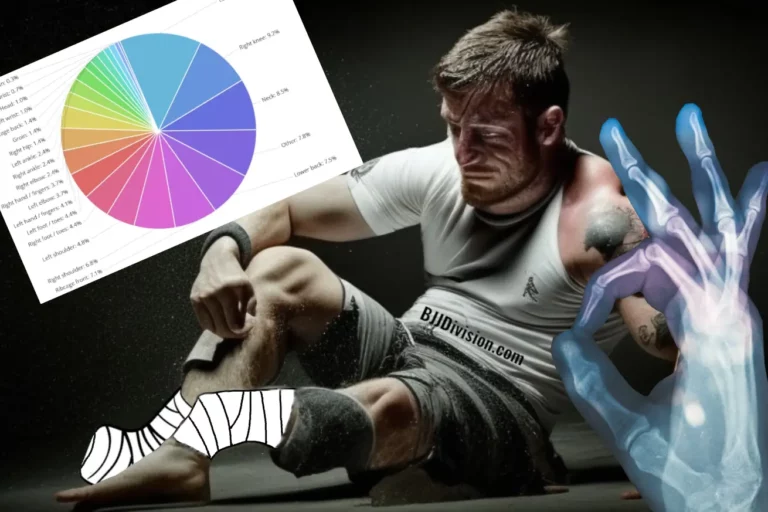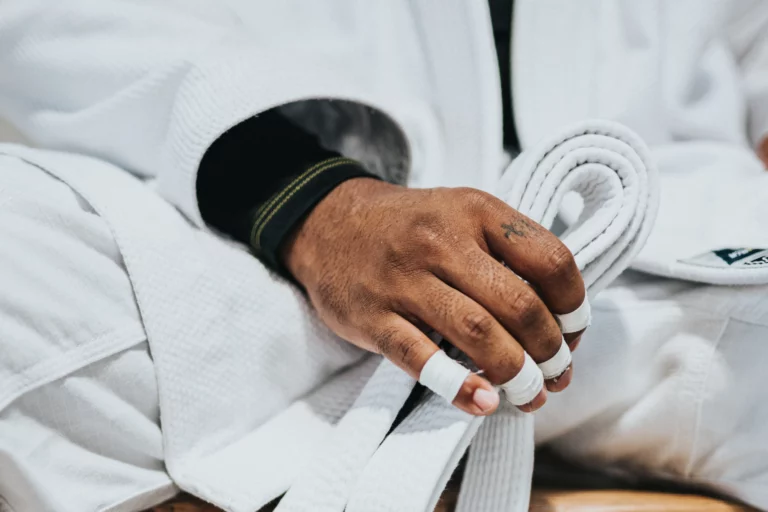BJJ Neck Pain: How to avoid it and deal with it

In Brazilian Jiu-Jitsu submission holds threaten to choke the opponent unconscious, break certain bones, dislocate joints, or tear ligaments. Many of these attacks as well as unfavorable body positions put a significant strain on the neck. Therefore, athletes are likely to injure their neck at some point during training or competing in the sport and experience the universally beloved BJJ neck pain.
The risk of neck pain and neck injuries in Jiu-Jitsu can’t be completely eliminated. Nevertheless, there are a few easy ways to avoid most neck injuries in BJJ. We will lay out what you have to do to stay healthy and how to deal with pain and injuries to get back on the mats as soon as possible.
Diagnosing Jiu Jitsu Neck Injuries

Your pain can be caused by different types of neck injuries. This article focuses on prevention and treatment rather than medical diagnosis. Nevertheless, some possible causes are:
- Tight muscle tissue
- Nerve damage
- Vertebrae damage
- Herniated or injured disk
- …
Most of the time, BJJ neck pain stems from tightness and temporary irritation. You can check out our article How common are injuries in BJJ? to dive into injury statistics and learn about frequencies of severe long-term injuries and minor injuries in BJJ. Whatever the cause might be, your spine is an important and at times fragile structure you should take good care of. When in doubt you should visit a doctor to get diagnosed properly and prevent long-term injury. Warning signs might be:
- Chronic pain
- Sever pain
- Pain spreading into the arms
- Restricted range of motion
- Nausea
- Headaches
Preventing Neck Pain and Neck injuries in BJJ

The following advice can be applied to training Jiu-Jitsu in general but is especially useful in preventing BJJ neck pain and neck injuries.
#1 Warm Up before every class
You probably heard this a thousand times, but you probably still don’t do it. I know it’s boring, but it is worth it. This does not only hold true for your neck. Try to make it to the gym a few minutes earlier and warm up your whole body before class. It will drastically reduce your risk of injury.
#2 Set up a Warm Up Routine
Hold on, the second tip is also about warming up? Yes, this shows you how important it really is. Here’s how to make your life a little easier: Set up your own Warm Up Routine according to your personal needs. This way you know exactly what to do every time you come to the gym. You can simply work through it on autopilot once you got used to it and even have a chat while warming up.
#3 Tap early
This one is as simple as it gets. As soon as you get uncomfortable you tap. Don’t wait for the pain to come. This is especially important for submission hold affecting the neck. You shouldn’t risk injury to your spine or any related muscles, nerves, or ligaments. Many times, the pain starts to arise after your partner lets go or only after you cooled down. In this case you will definitely regret not tapping later in the day. For sure, there is a place for pushing the limits in order prefect certain submission, usually in certain drilling sessions. In that case, you must cautious and know what to expect. While rolling you should generally tap early to support longevity.
#4 Strengthen your neck
Your neck will naturally get stronger as you progress in your Jiu-Jitsu journey since it is constantly strained. Besides regularly resisting to submission attempts you also use your head to control your opponent and push him in a certain directions. This means rolling and drilling will naturally strengthen your neck muscles and ligaments. If you feel like your neck is still too weak and doesn’t catch with your training, you might want to add some complementary exercises to strengthen your neck.
Important: Start slow and always move controlled. Don’t put to much load on your neck as it can worsen your pain and aggravate existing injuries. Here’s an example of how you should approach Neck Training:
Certainly, there are many more valuable exercises to strengthen your neck for every kind of movement. Having a solid neck also involves strengthening and balancing the rest of your upper back. Your shoulder and back muscles support your scapula and neck and greatly influence the muscles and nerves in the neck area.
#5 Balance your muscles
Everybody has a favorite side to drill and do all the other things involved in daily life. This generally leads to side-to-side imbalances. On top of that, using certain muscles groups more than other can lead to imbalances between opposing muscles (agonist and antagonist). As a result, your muscles are pulling unevenly resulting in tightness and pain. For example, if you do a lot of pulling motions involving your back you might want to incorporate some pushing motions to strengthen your chest and frontal shoulder muscles.
#6 Stretch after every class
You should stretch after every class not before class. Warm up before class but don’t put the strain of intense stretching on your muscles before starting a strenuous class. Stretching after class obviously won’t reduce your risk of injury during the class you just did, but over time your stretching efforts will amount in high flexibility and mobility. This means you will be able to get into positions requiring more mobility as well as be strong and resilient in these positions.
#7 Say no to a roll
Everyone that has ever trained Jiu-Jitsu knows that there are some guys at the gym that just spell disaster. The heavyweight that has no sense for size and health, the ego-driven athlete that has to go full force in every roll, the new guy that doesn’t know how to move controlled. All of them pose a threat to your health. You should only roll with people you feel save with. Usually, this means sticking to the people that show respect, communicate, and move controlled. Don’t let anyone pressure you into a roll.
#8 Choose the right intensity
You will usually not be able to roll with an all-out competition intensity every day of the week. This intensity generally poses a much higher risk of injury. Sometimes it is necessary, but you should choose wisely when to turn it up. Your body needs time to recover. Try plan your sessions for the week, switching it up between high/moderate/low intensity rolling, drill-only, conditioning and rest session. The following chart provides an example possibility to lay out your weekly training schedule. Your routine will depend on your training frequency and your specific needs and goals in the sport.

A schedule like this allows you to be a well-rounded athlete while taking care of your recovery needs.
#9 Moderation
“Everything in moderation”. You probably heard this one before. You should not only regulate training intensity, but also stretching and conditioning efforts. Too high of a frequency and intensity will do more harm than good. Experiment and find the routine that fits you. Listen to your body.
#10 Nutrition
Nutrition greatly impacts your overall health and therefore the health of your muscles, bones, nerves, ligaments, and joints. If you find yourself regularly injured despite having a solid training and recovery regime, take a closer look at your nutrition. Your life choices off the mat do translate to sport performance, injury prevention and recovery. The importance of proper nutrition should not be overlooked. Check out our complete guide to BJJ Nutrition soon.
Dealing with Neck Pain and Neck Injuries in BJJ

Again, the following advice can be applied Jiu-Jitsu related injuries in general but is especially useful in dealing with neck pain and neck injuries.
#1 Rest
We all love Jiu-Jitsu, and we know it’s hard to stay off the mats. But sometimes it is exactly what you need, and it will enhance your long-term health and progress. Reinjuring certain parts of your body repeatedly will force you to train ineffectively and provokes chronic and severe injuries. Take time off if you need to. Training won’t be as effective if you train injured anyway.
#2 Cool
Cooling is crucial if you have a fresh injury. It contracts the vessels in the cooled area to prevent blood and liquids from clocking up the injured area. Therefore, swelling and inflammation is reduced and optimal blood circulation in the injured area is promoted, resulting in less pain and a faster recovery.
#3 Heat
Should you cool or heat an injury? It depends. As stated above, you should always cool a fresh traumatic injury first to reduce swelling. If the pain stems from muscle tightness, heat or warmth is a good option to relax the muscles and relieve pain on your path to recovery. Heat treatment can be done with hot-water bags, warm bandages, and warm showers/baths.
#4 Massage
Massages help with relaxing the muscles and promote blood flow to the area which is crucial for injury recovery in every part of the body. They will be especially helpful with pain stemming from tight muscles which is often true for BJJ neck pain. As always, you should start slow. Applying more force doesn’t always help more. The main goal off massages is to promote blood flow. Listen to your body and make use of frequent massages of moderate intensity.
#5 Medication
In our opinion medication should always be your last resort. Many athletes and people in general overuse medication, especially pain killers. That does not mean that medication doesn’t have its place. Medication can reduce pain which will in itself lead to less tightness and reduce inflammation. Keep yourself accountable and monitor your medication usage. When in doubt, consult a doctor.
Conclusion
Unfortunately, not all injuries can be avoided and a stiff neck really sucks. There are no quick fixes for injuries in Jiu-Jitsu. You should take a holistic approach and do as much as possible to prevent injuries which is always easier than treating them. Don’t get discouraged if you got injured. By following the principles above, you will be able to reduce your risk of injury to a minimum as well as improve your recovery time in case you got unlucky. BJJ is not for the faint-hearted, but it rewards everyone that sticks with it.






